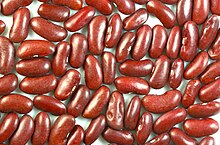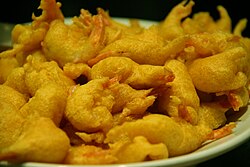Most ingredients in cooking are derived from living things. Vegetables, fruits, grains and nuts come from plants, while meat, eggs, and dairy products come from animals. Mushrooms and the yeast used in baking are kinds of fungi. Cooks also utilize water and minerals such as salt. Cooks can also use wine, an alcohol-based liquid from the fermentation of juices of grapes or other fruits.
Naturally occurring ingredients containt various amounts of molecules called proteins, carbohydrates and fats. They also contain water and minerals. Cooking involves a manipulation of the chemical properties of these molecules.
- Proteins
- Edible animal material, including muscle, offal, milk, eggs and egg whites, contains substantial amounts of protein. Almost all vegetable matter (in particular legumes and seeds) also includes proteins, although generally in smaller amounts. These may also be a source of essential amino acids. When proteins are heated they become denatured and change texture. In many cases, this causes the structure of the material to become softer or more friable - meat becomes cooked. In some cases, proteins can form more rigid structures, such as the coagulation of albumen in egg whites. The formation of a relatively rigid but flexible matrix from egg white provides an important component of much cake cookery, and alsunderpins many desserts based on meringue.
2. Carbohydrates
Carbohydrates include the common sugar, sucrose (table sugar), a disaccharide, and such simple sugars as glucose (from the digestion of table sugar) and fructose (from fruit), and starches from sources such as cereal flour, rice, arrowroot, potato. The interaction of heat and carbohydrate is complex.
Long-chain sugars such as starch tend to break down into simpler sugars when cooked, while simple sugars can form syrups. If sugars are heated so that all water of crystallisation is driven off, then caramelization starts, with the sugar undergoing thermal decomposition with the formation of carbon, and other breakdown products producing caramel. Similarly, the heating of sugars and proteins elicits the Maillard reaction, a basic flavor-enhancing technique.
An emulsion of starch with fat or water can, when gently heated, provide thickening to the dish being cooked. In European cooking, a mixture of butter and flour called a roux is used to thicken liquids to make stews or sauces. In Asian cooking, a similar effect is obtained from a mixture of rice or corn starch and water. These techniques rely on the properties of starches to create simpler mucilaginous saccharides during cooking, which causes the familiar thickening of sauces. This thickening will break down, however, under additional heat.
3. Fats
- Types of fat include vegetable oils and animal products such as butter and lard. Fats can reach temperatures higher than the boiling point of water, and are often used to conduct high heat to other ingredients, such frying or sauteing.
4. Water
- Cooking often involves water, which is frequently present in other liquids, both added in order to immerse the substances being cooked (typically water, stock or wine), and released from the foods themselves. Liquids are so important to cooking that the name of the cooking method used is often based on how the liquid is combined with the food, as in steaming, simmering, boiling, braising, and blanching. Heating liquid in an open container results in rapidly increased evaporation, which concentrates the remaining flavor and ingredients - this is a critical component of both stewing and sauce making.
5. Vitamins and minerals
- Vitamins are materials required for normal metabolism but which the body cannot manufacture itself and which must therefore come from soil. Vitamins come from a number of sources including fresh fruit and vegetables (Vitamin C), carrots, liver (Vitamin A), cereal bran, bread, liver e ( B vitamins), fish liver oil (Vitamin D) and fresh green vegetables (Vitamin K). Many minerals are also essential in small quantities including iron, calcium, magnesium and sulphur; and in very small quantities copper, zinc and selenium. The micronutrients, minerals, and vitamins[5] in fruit and vegetables may be destroyed or eluted by cooking. Vitamin C is especially prone to oxidation during cooking and may be completely destroyed by protracted cooking.




No comments:
Post a Comment